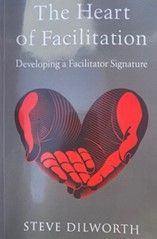Home News & Views Connecting with the art and heart of facilitation
Connecting with the art and heart of facilitation
 Sheila McGovern, FoNS Person-centred Practice Facilitator
Sheila McGovern, FoNS Person-centred Practice Facilitator
I decided to write this book blog for two reasons. Firstly, I love everything about my role as a facilitator. It is never boring, sometimes scary and always teaching me something new. I feel like I am relatively new to facilitation as have only formally been doing this work over the past six years. I know I still have a lot to learn and agree with the author in that I know I will also be learning about facilitating until my last breath. I suspect that long after retirement there will be conversations to facilitate, conflicts to give space to and light-bulb moments to be welcomed.
The second reason is because I thoroughly enjoyed the book and found that it re-ignited my passion for learning more about the art of facilitation. As I progressed through the book, I started to get ideas, some brilliant (if I may say so myself), some not so much, but when that level of creative thinking starts, I don’t mind so long as the ideas are flowing.
The Heart of Facilitation by Steve Dilworth 2021
 I came across The Heart of Facilitation when I connected with Steve after I wrote a short reflection about Love in Nursing for our February 2025 Newsletter. I have been working with the Foundation of Nursing Studies (FoNS) for over four years as an Associate Facilitator but have just recently joined the team as a permanent member of staff. I love working with this team. There is a huge amount of wisdom here, both old and new and everything in-between so I was delighted to get my hands on a book that might impart some more wisdom to me as a new (and slightly in-awe of everyone else’s wisdom) member of the team. I was not disappointed.
I came across The Heart of Facilitation when I connected with Steve after I wrote a short reflection about Love in Nursing for our February 2025 Newsletter. I have been working with the Foundation of Nursing Studies (FoNS) for over four years as an Associate Facilitator but have just recently joined the team as a permanent member of staff. I love working with this team. There is a huge amount of wisdom here, both old and new and everything in-between so I was delighted to get my hands on a book that might impart some more wisdom to me as a new (and slightly in-awe of everyone else’s wisdom) member of the team. I was not disappointed.
In this lovely, accessible book, the author shares his experience with you in a way that it feels like he is sitting next to you or at least in the same space as you. With his writing, he was able to take me into his groups with him, and I was able to feel the compassion, the conflict, and the ease of doing this job well when we are prepared to be present.
I felt like I was sitting with a wise old friend and soon realised that was most likely me connecting with my own inner knowing. You know that feeling when someone is talking or writing about something and you completely understand and “get it”. You have not read it anywhere else before, but it speaks to your experience. It is not dictatorial in any way, nor does it suggest that this is the only way, but encourages enough self-enquiry to guide us to our own intuitive knowing. It makes sense and it feels right.

This book takes the reader on a journey from understanding self in the role of facilitator to working with group dynamics with all its joys and challenges. We are introduced to The Iceberg Model which illustrates ways in which we can work with our distress and reconnect to our presence. We are also offered the guidance of a facilitation toolkit but not of your tick box variety. Everything shared is done so in a down-to-earth way so that you feel you are being conversed with and given other options to explore. When the author talks about balancing support and challenge, I loved the line “The key is to find a middle line between pussyfooting and clobbering”. How often I have walked that line and slipped over into one or both at times?
The book draws to a close with the chapter on professional development, where we are reminded of the need for our commitment to lifelong learning and research awareness. Here the author shares what has worked for him and ideas for us to think about when broadening our receptivity to learning. Having just completed an introduction to dramatherapy short course at Queen Margaret’s University in Edinburgh, this resonates with me and helps reassure me that I am paving my own facilitator path. Throughout the book we find quotes from philosophers, authors, poets and mystics to help us connect with the chapters on different levels.
The Oxford English Dictionary defines facilitate the verb as: to make an action or process easy or easier.
Heron (1999) says “what I mean by facilitator …is a person who has the role of empowering participants…”
In this book, Steve Dilworth combines both in his definition of the role when he says “we, who claim to be facilitators, are present to make it easier for participants; in other words, to empower.”
The clever addition of the word present in that sentence links both definitions and brings an understanding of what is so vital to the role – the ability to be present.
If you choose to read this book you will likely come up with your favourite sections; those that speak to your experience. I will share my key learning areas here.
We are introduced to facilitator distress in all its forms and instead of it feeling like something I shouldn’t still get, I am now feeling a lot better that there is a name for it and that it is perfectly normal and not insurmountable.
I found the chapter that talks about conflict in interpersonal relationships grounding and valuable. “Confronting something does not necessarily mean conflict” is now etched into a part of my brain and I know this will change the way I work with conflict in groups.
The iceberg model is an effective way of exploring our levels of distress but the insights I had around the deeply ingrained ‘vicious humility’ was particularly powerful for me, and I feel an understanding has been unlocked around this that I had not quite grasped before.
To conclude, I was looking forward to passing this book on to colleagues, but I feel that it has become one of those books that I will go back to again and again and may be gifting copies instead of sharing! In my opinion, it is a great guidebook to facilitation and will sit close-by for the foreseeable future. I recommend this book to anyone who is interested in facilitating at any level.
The Heart of Facilitation by Steve Dilworth
Also by the same author: Mourning Walk
References
Heron, J., 1999. The Complete Facilitator’s Handbook. London: Kogan Page.
Comments are closed.

